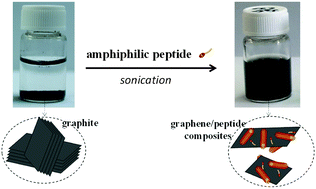Direct exfoliation of graphite into graphene in aqueous solutions of amphiphilic peptides†
Abstract
Different amphiphilic peptides were used to mediate the direct exfoliation of graphite into few-layered graphene flakes in aqueous solutions. Charge was found to be an important parameter in determining their graphite exfoliating efficiency. The anionic molecules were more favorable than the cationic ones leading to a higher efficiency. The gemini-type peptide IleIleIleCys–CysIleIleIle (I3C–CI3) exhibited the highest efficiency, which might be attributed to its specific physicochemical properties and interactions with graphene sheets. I3C–CI3 adsorbed onto the graphene surface as either monomers or self-assembled nanoaggregates. These adsorbed species increased both electrostatic and steric repulsions between the graphene/I3C–CI3 composites. More interestingly, the graphene/I3C–CI3 composites showed a reversible pH-dependent dispersion/aggregation. This behavior resulted from the pH-sensitive protonation of the peptide molecules and was rarely found in the graphene dispersions exfoliated by traditional surfactants. Moreover, the graphene/I3C–CI3 dispersion was used to fabricate free-standing macroscopic composite films that contained different nanostructures. The study expands the library of available agents for direct graphite exfoliation to produce graphene sheets. Employing peptide molecules as graphene exfoliating and stabilizing agents avoids the use of toxic reagents, which may allow fabrication of functional composite materials for biocompatible applications.

- This article is part of the themed collection: 2016 Journal of Materials Chemistry B Most Accessed Manuscripts

 Please wait while we load your content...
Please wait while we load your content...